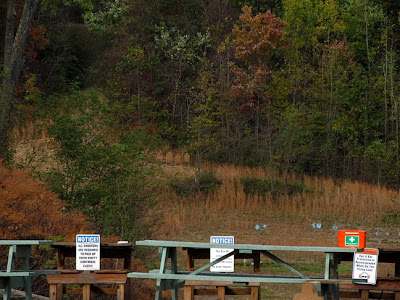I shot a sniper team match recently at Greenport Tactical. Each team consisted of a spotter and sniper. Most of the spotters shot an AR platform in
.223. Most of the snipers used a .308 bolt
action with lots of optical glass. A few
snipers used a .308 or .223 AR platform.
I had a lot of fun. I didn’t anticipate winning but my partner and
I weren’t in last place either. This
match brings out a lot of very good shooters.
One of the advantages of shooting these matches is to find
areas I’m deficient in. These problems
can be skill set or equipment based.
Once I discover the problem I then have to decide if I want to resolve
it.
What, live with deficiencies? Sure. Here
are two examples.
One stage called for the sniper to shoot through several
different canted slots in a barricade at a 4x6-inch steel plate 126 yds
away.
 |
| The shooter has to tilt the rifle and the sights to line up on the target. Times of 300 seconds were not uncommon, but a miss was only 2.5 seconds added to your time! |
Canting the rifle and sights causes a serious change in impact points. You
could learn to apply a correction factor based on experience and training over
several distances or simply accept the fact that you’ll miss the center of mass
but hit the man. I’d like to improve
that skill set.
 |
| Here's the target she's trying to hit. A white 4x6-inch steel plate at 126 yards. After a hit the plate twists, rocks and moves in unpredictable ways. |
Another stage had you spotting playing cards at 76 yds. My 10X 50mm binoculars didn’t have enough
oomph to clearly resolve the cards so I wasn’t much help to the sniper. I could
cure this problem with more magnification, which is harder to hold steady. Another solution to this problem would be
better optics with the same power and a larger front lens to gather more light
and improve resolution, which is more expensive.
This is not a problem I’ll attempt to resolve. I just can’t see the need to identify your
target based on name badges worn at 100 yards. I just don’t anticipate having to solve that
problem.
And what about the match itself? That’s a sticky wicket as the Brits say.
 |
| Shooting off the 'dog house' roof at 260 yards. |
 |
| Each sniper had to put 5 rounds in their numbered target. After everyone shot, the targets were scored and replaced. Oh, you can't see the targets? |
 |
| Here's a better look at the targets. Teach team had their own number. |
One of the contestants, before a single round was fired
said, “They have taken a rifle match and turned it into a pistol match.” I have to agree.
The sniper fired more shots from his sidearm
than he did from his rifle. The scoring was based on IDPA so low time won. A miss was 5 points or 2.5 seconds added to
your raw time. The impact of this
scoring system is tremendous.
One safety officer put it this way. “Look, this isn’t sour grapes. I’m not competing, but the misses have no
impact on your score. Time is what’s
important. You can shoot fast enough to
win simply by throwing all your rounds away on most stages.”
He was right. One of best
shooters scored nine hits in just under 70 seconds on one stage. Given the distance and shooting scenario,
this is tremendous shooting. With my AR
and the 5 round sniper limit in the magazine, I could have emptied the magazine,
reloaded and done 4 more rounds in 30 seconds. All misses. My penalty?
The match director/statistician would have added 22.5 seconds to my
score giving me a world beating 52.5 second score. If all I wanted to do was win a plaque, I
could have done that by missing every target and shooting fast.
What about the failure-to-do-right penalty? It’s very hard to give to someone dumping
rounds when they claim they are just missing.
If I remember correctly, IDPA now allows you to dump rounds.
Fortunately, nobody on my squad was a gamesman and we all
shot it with the intention of hitting the target as best we could.
The tactical content?
That’s easy. Matches
and the resulting pressure lets you discover where your weaknesses are and what
equipment works under what conditions.
One of the spotters had a sweet system and a great plan. He mounted a green indicator laser on his
tripoded spotting scope. The plan, and I
liked it a lot, was to find the playing card and illuminate it for the
sniper. With the two of them working
together they could have saved a lot of time and racked up points. They had tried this on a nice summer night
and it worked quite well.
The first problem was a 50-degree day was too cold for the
laser to operate. They solved that by
keeping the laser in an inner pocket until it was needed. Then the laser was too dim to see on a
playing card in the bright sunlight. No
good solution seems available unless you move from a low power class three
laser to a class 4, 1 watt or better laser.
That’s takes a lot of power and most diode lasers don’t have the tight
beams you need to select one playing card.
Sounds like you need military grade equipment.
My friend may not choose to solve that problem, but at least
he’s aware of it. To be fore-warned is to
be fore-armed and that’s tactical.

This comment has been removed by a blog administrator.
ReplyDelete